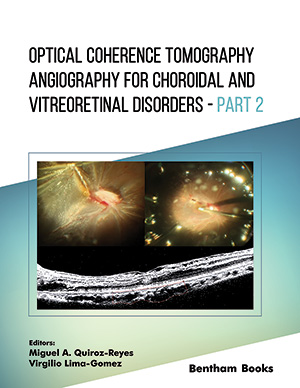[1]
Fujimura M, Bang OY, Kim JS. Moyamoya disease. Front Neurol Neurosci 2016; 40: 204-20.
[2]
Hayashi K, Horie N, Suyama K, Nagata I. An epidemiological survey of Moyamoya disease, unilateral Moyamoya disease and quasi-Moyamoya disease in Japan. Clin Neurol Neurosurg 2013; 115(7): 930-3.
[3]
Scott RM, Smith ER. Moyamoya disease and Moyamoya syndrome. N Engl J Med 2009; 360(12): 1226-37.
[4]
Kim JS. Moyamoya disease: Epidemiology, clinical features, and diagnosis. J Stroke 2016; 18(1): 2-11.
[5]
Chen PC, Yang SH, Chien KL, Tsai IJ, Kuo MF. Epidemiology of Moyamoya disease in Taiwan: A nationwide population-based study. Stroke 2014; 45(5): 1258-63.
[6]
Kim T, Lee H, Bang JS, Kwon OK, Hwang G, Oh CW. Epidemiology of Moyamoya disease in Korea: Based on National Health Insurance Service Data. J Korean Neurosurg Soc 2015; 57(6): 390-5.
[7]
Kainth D, Chaudhry SA, Kainth H, Suri FK, Qureshi AI. Epidemiological and clinical features of Moyamoya disease in the USA. Neuroepidemiology 2013; 40(4): 282-7.
[8]
Fujimura M, Tominaga T. Diagnosis of Moyamoya disease: International standard and regional differences. Neurol Med Chir (Tokyo) 2015; 55(3): 189-93.
[9]
Hayashi K, Horie N, Izumo T, Nagata I. A nationwide survey on unilateral Moyamoya disease in Japan. Clin Neurol Neurosurg 2014; 124: 1-5.
[10]
Kelly ME, Bell-Stephens TE, Marks MP, Do HM, Steinberg GK. Progression of unilateral Moyamoya disease: A clinical series. Cerebrovasc Dis 2006; 22(2-3): 109-15.
[11]
Zhang Q, Wang R, Liu Y, et al. Clinical features and long-term outcomes of unilateral Moyamoya disease. World Neurosurg 2016; 96: 474-82.
[12]
Chen JB, Liu Y, Zhou LX, Sun H, He M, You C. Increased prevalence of autoimmune disease in patients with unilateral compared with bilateral Moyamoya disease. J Neurosurg 2016; 124(5): 1215-20.
[13]
Wan M, Duan L. Recent progress in hemorrhagic Moyamoya disease. Br J Neurosurg 2015; 29(2): 189-91.
[14]
Liu P, Han C, Li DS, Lv XL, Li YX, Duan L. Hemorrhagic Moyamoya disease in children: Clinical, angiographic features, and long-term surgical outcome. Stroke 2016; 47(1): 240-3.
[15]
Ge P, Zhang Q, Ye X, et al. Clinical features of hemorrhagic Moyamoya disease in China. World Neurosurg 2017; 106: 224-30.
[16]
Li Q, Qu L, Yuan Y, et al. Analysis of the clinical characteristics of hemorrhagic Moyamoya disease in the Jilin province of northeastern China: A single-center study of 212 cases. Biomed Rep 2018; 8(2): 191-7.
[17]
Jiang H, Ni W, Xu B, et al. Outcome in adult patients with hemorrhagic Moyamoya disease after combined extracranial-intracranial bypass. J Neurosurg 2014; 121(5): 1048-55.
[18]
Hamada J, Hashimoto N, Tsukahara T. Moyamoya disease with repeated intraventricular hemorrhage due to aneurysm rupture. Report of two cases. J Neurosurg 1994; 80(2): 328-31.
[19]
Jang DK, Lee KS, Rha HK, et al. Clinical and angiographic features and stroke types in adult Moyamoya disease. AJNR Am J Neuroradiol 2014; 35(6): 1124-31.
[20]
Wan M, Han C, Xian P, Yang WZ, Li DS, Duan L. Moyamoya disease presenting with subarachnoid hemorrhage: Clinical features and neuroimaging of a case series. Br J Neurosurg 2015; 29(6): 804-10.
[21]
Saeki N, Nakazaki S, Kubota M, et al. Hemorrhagic type Moyamoya disease. Clin Neurol Neurosurg 1997; 99(Suppl. 2): S196-201.
[22]
Veselinovic N, Zidverc-Trajkovic J, Semnic R, Tomic G, Sternic N, Bjelan M. Moyamoya, unilateral to bilateral in one year. Vasa 2014; 43(4): 284-6.
[23]
Houkin K, Abe H, Yoshimoto T, Takahashi A. Is “unilateral” Moyamoya disease different from Moyamoya disease? J Neurosurg 1996; 85(5): 772-6.
[24]
Ridker PM, Everett BM, Thuren T, et al. Antiinflammatory therapy with Canakinumab for Atherosclerotic disease. N Engl J Med 2017; 377(12): 1119-31.
[25]
Funaki T, Fushimi Y, Takahashi JC, et al. Visualization of periventricular collaterals in Moyamoya disease with flow-sensitive black-blood magnetic resonance angiography: Preliminary experience. Neurol Med Chir (Tokyo) 2015; 55(3): 204-9.
[26]
Abhinav K, Furtado SV, Nielsen TH, et al. Functional outcomes after revascularization procedures in patients with hemorrhagic moyamoya disease. Neurosurgery 2019. [EPub ahead of Print].
[27]
Li Q, Gao Y, Xin W, et al. Meta-analysis of the prognosis of different treatments of symptomatic moyamoya disease. World Neurosurg 2019. [EPub ahead of Print].
[28]
Nomura S, Yamaguchi K, Akagawa H, et al. Genotype-phenotype
correlation in long-term cohort of Japanese patients with moyamoya
disease Cerebrovascular diseases (Basel, Switzerland) 2019. [EPub ahead of Print].





























